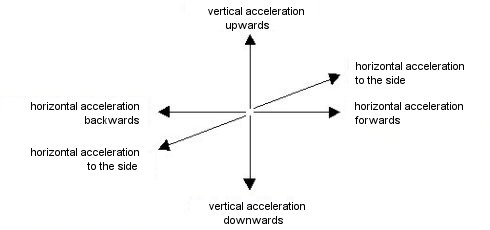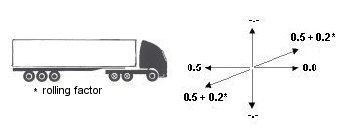Jolting is defined as vibration and oscillation caused by impact which then subsides. Depending upon causation (roadway, rail track, switches, rough seas transport, handling and storage operations etc.), jolting may be regular or irregular.
Impacts
Impacts are dynamic, mechanical stresses arising from the abrupt acceleration of masses. A distinction is drawn between positive and negative acceleration. Such acceleration forces are not generally repeated at regular intervals, but they do occur with greater or lesser frequency at varying intensities during transport, handling and storage operations.
Vertical impact: Tipping (by exceeding tilting moment), tumbling (rolling edge over edge), bumping (during abrupt hoisting, setting-down or bumping by other cargoes or the container by means of container bridge or on-board gear).
Horizontal impact: Jolting impacts (during switching), bumping against vehicle walls or other cargo (caused by centrifugal forces at curves and when traveling through switches, starting up).
Vibration
Vibration stresses, which occur during goods transport on all kinds of means of transport, may be divided into:
- regular and
- irregular vibration stresses
Irregular vibration is generated by impacts due to unevenness of the travel way. Depending upon the nature of the travel way, e.g. abutted rails, such excitation may also cause regular vibration.
Components in machinery, computers, plant etc. are at particular risk as they may be caused to resonate by the typical vibrations of a means of transport. If this is a risk, suitable packaging experts should be consulted.
Acceleration
Negative and positive accelerations are dynamic, mechanical stresses which occur in two main groups in goods transport:
- regular acceleration and
- irregular acceleration.
Irregular acceleration occurs during cornering or passage over switches, during braking, starting up, hoisting and lowering. Such acceleration forces are not generally repeated, but they may occur several times at varying intensities during a transport operation. These are the typical stresses of land transport and transport, handling and storage operations.
Other dynamic stresses are localized impact stresses: abrasion (dragging, pushing, pulling) or chafing (friction).
The following diagrams illustrate the various types of acceleration and associate them with individual means of transport.

Stresses in road transport:
Dynamic stresses experienced in the various means of transport in g [m/s²]
CTU packing guidelines*, page 8:

*Guidelines for the packing of cargo, other than bulk cargo, into or onto cargo transport units (CTUs) applicable to transport operations by all surface and water modes of transport
VDI guidelines 2700 ff **

*According to VDI guidelines, the rolling factor must be taken into account for unstable loads.
**Load securing on road vehicles must be carried out in accordance with best current practice which is currently embodied, as provided in German legislation, in VDI guidelines 2700 ff.
Hafenfachschule Bremen*:
Details relating to combined sea-road-sea transport operations

*A technical college providing practical training which, for safety reasons and for simplicity's sake, recommends higher values.
Stresses in rail transport:
CTU packing guidelines*, page 8:

*Guidelines for the packing of cargo, other than bulk cargo, into or onto cargo transport units (CTUs) applicable to transport operations by all surface and water modes of transport
GDV:

Eastern European rail transport uses semiautomatic coupling systems. To initiate the coupling procedure, these couplings require a minimum speed of 9 km/h. Since these coupling procedures are frequently performed at higher speeds due to corrosion, accelerations of up to 10 g and in exceptional cases even up to 18 g may occur.
Stresses in maritime transport:
In maritime transport, the accelerations to be expected depend on the ship's dimensions and shape, its center of gravity and center of buoyancy, its cruising speed and linear and rotational movements or the interaction of several of the above-stated movements. Examples of the movements experienced by a ship at sea are contained in the CTU packing guidelines, page 7.
CTU packing guidelines, page 8:

In maritime transport, calculations should always be based on the least favorable assumptions. Acceleration values of 1.0 g should therefore be assumed. This also applies to securing measures relating to cargoes transported by sea in containers, road vehicles, freight cars and trailers.
German Federal Bulletin

The guideline entitled "Bekanntmachung von Änderungen der Richtlinien für die sachgerechte Stauung und Sicherung von Ladung bei der Beförderung von Seeschiffen" ("Publication of amendments to guidelines for the correct stowage and securing of cargoes for carriage in ocean-going ships"), 14th February 1996, contains in Table 2 the basic acceleration values in m/s² for the various deck areas and lengthwise portions of a ship. Tables 3 and 4 contain correction factors for other ship lengths and speeds together with the ratio of width and metacentric height.
Stresses in inland waterway transport:
The accelerations arising in inland waterway transport are negligible and may be calculated on the basis of the stresses arising in road transport.
Stresses in air transport:
Delvag Luftfahrtvers. AG:

Stresses during cargo handling:
During cargo handling, stresses of 1.0 g may be assumed. Jerky lifting and setting down may generate higher g values.